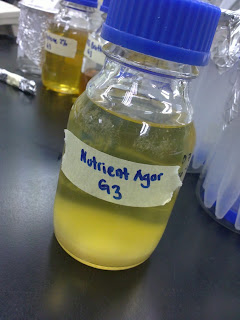Nutrient agar is a microbiological growth medium commonly used for the routine cultivation of non fastidious bacteria. It is useful because it remains solid even at relatively high temperatures. Also, bacteria grown in nutrient agar grows on the surface, and is clearly visible as small colonies. Nutrient agar consists of peptone, beef extract and agar.
This relatively simple formulation provides the nutrients necessary for the replication of a large number of microorganisms that are not excessively fastidious. The beef extract contains water soluble substances including carbohydrates, vitamins, organic nitrogen compounds and salts. Peptones are the principle sources of organic nitrogen, particularly amino acids and long chained peptides.
After we prepare the nutrient agar and other materials needed, we have to sterilize them in order to prevent them from any sources of contamination as well as to ensure them being free from any types of microbes. The process of sterilization may vary with the different types of requirements for handling and disinfecting the materials.
PROCEDURES.
1. 1. 7.00 g of nutrient powder was weighed by using analytical balance and was put in the scott bottles.
2. 2. 250 ml of distilled water was measured by measuring cylinder and was add up in the scott bottle containing nutrient powder. Nutrient media was mixed up with distilled water.
3. 3. Recap the bottles loosely and set aside for the sterilization.
4. Steps one to three was repeated for 10.45g in 100 ml MRS broth and 5.00 g in 250 ml peptone 2%.
5. 4.Then, all media was sterilized at 121˚C for 15 minutes by using autoclave.
1.
 |
| 7.00 g nutrient agar |
 |
| 7.00 g in 250 mL nutrient agar |
 |
| 10.45 g MRS broth |
 |
| 10.45 g MRS broth in 100 mL |
 |
| 5.00 g peptone in 250 mL. |
 |
| 5.00 g peptone. |
 | |
| autoclave |
 |
| Materials and reagents. |
DISCUSSION
An autoclave is an instrument used to sterilize equipment and supplies by subjecting them to high pressure saturated steam at 121 °C or more, typically for 15–20 minutes depending on the size of the load and the contents.
The autoclave comes in several types. One of the simplest autoclaves looks a great deal like a pressure cooker. It is a large pot with a gauge on top and bolts that fasten the top to the pot. The idea behind this is that water inside a pressurized container can be heated above the boiling point. It will only reach 212 degrees Fahrenheit (100 Celsius) in an open container. However, in a pressurized autoclave, the water will reach much higher temperatures.
When microbiological media has been made, it still has to be sterilized because of microbial contamination from air, glassware, hands, etc. Within a few hours there will be thousands of bacteria reproducing in the media so it has to be sterilized quickly before the microbes start using the nutrients up. The sterilization process is a 100% kill, and guarantees that the medium will stay sterile UNLESS exposed to contaminants by less that adequate aseptic technique to exposure to air.
Media sterilization is carried out with the autoclave, basically a huge steam cooker. Steam enters into a jacket surrounding the chamber. When the pressure from the steam is at a certain point in the jacket, a valve allows the steam to enter the chamber. The pressure will go up over 15 pounds per square inch (psi): at this point the timer begins to count down---usually for 15 minutes, depending on the type of media. The high pressure in a closed container allows the temperature to go above the highest temperature one could get by just boiling, around 121 degrees C. Therefore, the parameters for sterilization with an autoclave are 121 C at >15 psi for 15 minutes. Fifteen minutes is the thermal death time for most organisms (except some really hardy sporeformers).
Conclusion
The preparation of nutrient agar for culturing microorganism is done by using autoclaving technique in order the material to be sterilized. It is very important to ensure that all of the trapped air is removed. Proper autoclave treatment will inactivate all fungi, bacteria, viruses and also bacterial spores, which can be quite resistant, It will not necessarily eliminate all prions.
REFERENCES
1.
































